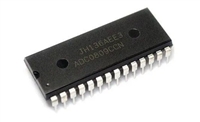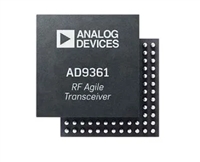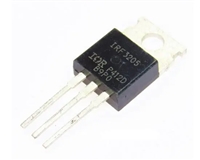Notes:
13. Systematic Jitter contributed by the transmitter is defined as the
combination of Duty Cycle Distortion and Data Dependent Jitter.
Systematic Jitter is measured at 50% threshold using a 155.52 MBd
(77.5 MHz square-wave), 27 - 1 psuedorandom data pattern input
signal.
14. Random Jitter contributed by the transmitter is specified with a
155.52 MBd (77.5 MHz square-wave) input signal.
15. This specification is intended to indicate the performance of the
receiver section of the transceiver when Input Optical Power signal
characteristics are present per the following definitions. The Input
Optical Power dynamic range from the minimum level (with a
window time-width) to the maximum level is the range over which
1. This is the maximum voltage that can be applied across the
Differential Transmitter Data Inputs to prevent damage to the input
ESD protection circuit.
2. The outputs are terminated with 50 Ω connected to VCC -2 V.
3. The power supply current needed to operate the transmitter is
provided to differential ECL circuitry. This circuitry maintains a nearly
constant current flow from the power supply. Constant current
operation helps to prevent unwanted electrical noise from being
generated and conducted or emitted to neighboring circuitry.
4. This value is measured with the outputs terminated into 50 Ω
connected to VCC - 2 V and an Input Optical Power level of -14 dBm
average.
the receiver is guaranteed to provide output data with a Bit Error
5a. The power dissipation of the transmitter is calculated as the sum of
the products of supply voltage and current.
-10
Rate (BER) better than or equal to 1 x 10
.
•
•
•
At the Beginning of Life (BOL)
5b. The power dissipation of the receiver is calculated as the sum of
the products of supply voltage and currents, minus the sum of the
products of the output voltages and currents.
6. This value is measured with respect to VCC with the output terminated
into 50 Ω connected to VCC - 2 V.
Over the specified operating temperature and voltage ranges
Input is a 155.52 MBd, 223 - 1 PRBS data pattern with 72 “1”s and
72“0”s inserted per the CCITT (now ITU-T) recommendation G.958
Appendix I.
•
Receiver data window time-width is 1.23 ns or greater for the
clock recovery circuit to operate in. The actual test data window
time-width is set to simulate the effect of worst case optical input
jitter based on the transmitter jitter values from the specification
tables. The test window time-width is AFBR-5905Z 3.32 ns.
Transmitter operating with a 155.52 MBd, 77.5 MHz square-wave,
input signal to simulate any cross-talk present between the
transmitter and receiver sections of the transceiver.
7. The output rise and fall times are measured between 20% and 80%
levels with the output connected to VCC -2 V through 50 Ω. 8. These
optical power values are measured with the following conditions: •
The Beginning of Life (BOL) to the End of Life (EOL) optical power
degradation is typically 1.5 dB per the industry convention for long
wavelength LEDs. The actual degradation observed in Avago’s 1300
nm LED products is < 1 dB, as specified in this data sheet. • Over the
specified operating voltage and temperature ranges. • With 25 MBd
(12.5 MHz square-wave), input signal. • At the end of one meter of
noted optical fiber with cladding modes removed. The average
power value can be converted to a peak power value by adding 3
dB. Higher output optical power transmitters are available on special
request. Please consult with your local Avago sales representative for
further details.
9. The Extinction Ratio is a measure of the modulation depth of the
optical signal. The data “1” output optical power is compared to
the data “0” peak output optical power and expressed in decibels.
With the transmitter driven by a 25 MBd (12.5 MHz square-wave)
input signal, the average optical power is measured. The data “1”
peak power is then calculated by adding 3 dB to the measured
average optical power. The data “0” output optical power is found
by measuring the optical power when the transmitter is driven by a
logic“0”input. The extinction ratio is the ratio of the optical power at
the“1”level compared to the optical power at the“0”level expressed
in decibels.
•
16. All conditions of Note 15 apply except that the measurement is made
at the center of the symbol with no window time-width.
17. Systematic Jitter contributed by the receiver is defined as the
combination of Duty Cycle Distortion and Data Dependent Jitter.
Systematic Jitter is measured at 50% threshold using a 155.52 MBd
(77.5 MHz square-wave), 27 - 1 psuedorandom data pattern input
signal. 18. Random Jitter contributed by the receiver is specified with
a 155.52 MBd (77.5 MHz square-wave) input signal.
19. This value is measured during the transition from low to high levels
of input optical power.
20. This value is measured during the transition from high to low levels of
input optical power. At Signal Detect Deassert, the receiver outputs
Data Out and Data Out Bar go to steady PECL levels High and Low
respectively.
21. The Signal Detect output shall be asserted within 100 µs after a step
increase of the Input Optical Power.
22. Signal detect output shall be de-asserted within 350 µs after a step
decrease in the Input Optical Power. At Signal Detect Deassert, the
receiver outputs Data Out and Data Out Bar go to steady PECL levels
High and Low respectively.
10. The transmitter will provide this low level of Output Optical
Power when driven by a logic “0” input. This can be useful in link
troubleshooting.
23. The AFBR-5905Z transceiver complies with the requirements for the
trade-offs between center wavelength, spectral width, and rise/
fall times shown in Figure 11. This figure is derived from the FDDI
PMD standard (ISO/IEC 9314-3 : 1990 and ANSI X3.166 - 1990) per
the description in ANSI T1E1.2 Revision 3. The interpretation of this
figure is that values of Center Wavelength and Spectral Width must
lie along the appropriate Optical Rise/ Fall Time curve.
11.TherelationshipbetweenFullWidthHalfMaximumandRMSvaluesfor
Spectral Width is derived from the assumption of a Gaussian shaped
spectrum which results in a 2.35 X RMS = FWHM relationship.
12. The optical rise and fall times are measured from 10% to 90% when
the transmitter is driven by a 25 MBd (12.5 MHz square-wave) input
signal. The ANSI T1E1.2 committee has designated the possibility of
defining an eye pattern mask for the transmitter optical output as
an item for further study. Avago will incorporate this requirement
into the specifications for these products if it is defined. The HFBR-
5905 products typically comply with the template requirements of
CCITT (now ITU-T) G.957 Section 3.2.5, Figure 2 for the STM-1 rate,
excluding the optical receiver filter normally associated with single
mode fiber measurements which is the likely source for the ANSI
T1E1.2 committee to follow in this matter.
For product information and a complete list of distributors, please go to our web site: www.avagotech.com
Avago, Avago Technologies, and the A logo are trademarks of Avago Technologies, Limited in the United States and other countries.
Data subject to change. Copyright © 2008 Avago Technologies Limited. All rights reserved.
5989-3083EN - February 20, 2008






 SI2301 N沟道MOSFET:资料手册参数分析
SI2301 N沟道MOSFET:资料手册参数分析

 ADC0809逐次逼近寄存器型模数转换器:资料手册参数分析
ADC0809逐次逼近寄存器型模数转换器:资料手册参数分析

 AD9361捷变收发器:全面参数解析与关键特性概览
AD9361捷变收发器:全面参数解析与关键特性概览

 IRF3205功率MOSFET:资料手册参数分析
IRF3205功率MOSFET:资料手册参数分析
